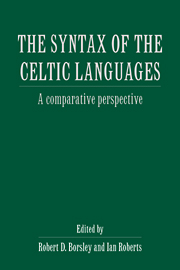Book contents
- Frontmatter
- Contents
- List of contributors
- Introduction
- 1 Long head movement in Breton
- 2 Some syntactic effects of suppletion in the Celtic copulas
- 3 Fronting constructions in Welsh
- 4 Bod in the present tense and in other tenses
- 5 Pronominal enclisis in VSO languages
- 6 Aspect, agreement and measure phrases in Scottish Gaelic
- 7 A minimalist approach to some problems of Irish word order
- 8 Subjects and subject positions in Irish
- 9 Negation in Irish and the representation of monotone decreasing quantifiers
- 10 On structural invariance and lexical diversity in VSO languages: arguments from Irish noun phrases
- References
- Index
3 - Fronting constructions in Welsh
Published online by Cambridge University Press: 18 December 2009
- Frontmatter
- Contents
- List of contributors
- Introduction
- 1 Long head movement in Breton
- 2 Some syntactic effects of suppletion in the Celtic copulas
- 3 Fronting constructions in Welsh
- 4 Bod in the present tense and in other tenses
- 5 Pronominal enclisis in VSO languages
- 6 Aspect, agreement and measure phrases in Scottish Gaelic
- 7 A minimalist approach to some problems of Irish word order
- 8 Subjects and subject positions in Irish
- 9 Negation in Irish and the representation of monotone decreasing quantifiers
- 10 On structural invariance and lexical diversity in VSO languages: arguments from Irish noun phrases
- References
- Index
Summary
Like all the Celtic languages, Welsh very commonly displays word orders other than the canonical VSO, the unmarked surface word order. Traditional Welsh grammar distinguishes between two constructions which are non-VSO: the so-called ‘mixed’ and ‘abnormal’ word orders. Both display what, in a pretheoretical sense, we might call ‘fronting’ of some constituent, although the pragmatic function of this fronting is typically claimed to be very different in each case (see, for example, Fife and King 1991; Watkins 1991; and other papers in Fife and Poppe 1991). In this chapter I consider the derivation of each of these constructions from the point of view of the principles-and-parameters framework of generative grammar.
I will show that the ‘mixed’ construction, which I refer to as the cleft construction in the text, is best analysed in terms of the CP-recursion analysis of Rizzi and Roberts (1989) and Cardinaletti and Roberts (1991). We will see that the clefted constituent is sited in the specifier position of a CP which is itself the complement to a higher complementizer. On the other hand the ‘abnormal’ sentences (a term I keep for the sake of convenience) actually involve adjunction to a matrix CP, and no CP-recursion is involved.
The chapter is structured as follows: section 1 outlines the data and illustrates the major differences between the two construction types. Section 2 discusses some previous generative treatments of one of the types of fronting under discussion, the cleft, and shows that these analyses share a common problem when more data are taken into consideration. Section 3 presents an alternative analysis of both the cleft and the abnormal constructions, and section 4 defends this analysis in detail.
- Type
- Chapter
- Information
- The Syntax of the Celtic LanguagesA Comparative Perspective, pp. 97 - 124Publisher: Cambridge University PressPrint publication year: 1996
- 7
- Cited by



